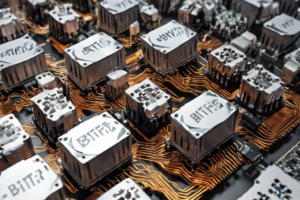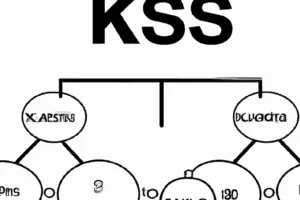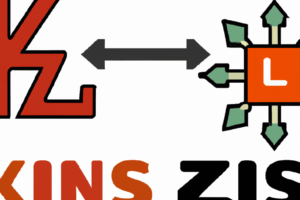
Unraveling the Power of Blockchain: Pioneering a Decentralized Internet Era
1. The Emergence of Web 3.0
Web 3.0, often referred to as the ‘Semantic Web', is the next generation of the internet that promises to create a more connected, open, and intelligent network. Unlike Web 2.0, which is centralized and controlled by a few tech giants, Web 3.0 aims to decentralize the internet, giving users control over their data and online experiences.
2. Blockchain as the Backbone of Web 3.0
Blockchain technology, with its inherent properties of transparency, immutability, and decentralization, is poised to play a crucial role in the development of Web 3.0. It can provide the necessary infrastructure for a decentralized internet, where data is not owned by a few corporations but by the users themselves.
3. User Empowerment and Data Ownership
Web 3.0, powered by blockchain, can fundamentally change the way we interact with the internet. It can empower users by giving them control over their personal data, allowing them to decide who can access their information and how it can be used.
4. The Potential for Greater Privacy and Security
The decentralized nature of Web 3.0 and blockchain can lead to enhanced privacy and security. By eliminating the need for intermediaries, users can interact directly with each other, reducing the risk of data breaches and privacy violations.
5. Challenges and Future Prospects
Despite its potential, the transition to Web 3.0 faces several challenges, including scalability issues, regulatory uncertainties, and the need for widespread adoption. However, as technology evolves and these challenges are addressed, the dawn of a decentralized internet could be closer than we think.
The Question of True Decentralization
One of the most contentious aspects of Web 3.0 and the role of blockchain in decentralizing the internet is the question of whether true decentralization can actually be achieved. Proponents argue that blockchain technology, with its distributed ledger and consensus mechanisms, can eliminate the need for central authorities and intermediaries, thereby giving users more control over their data. This decentralization, they argue, will lead to a more democratic and equitable internet.
However, skeptics point out that while blockchain may decentralize some aspects of the internet, it may also create new power structures. For instance, miners who validate transactions on blockchain networks can become powerful entities, potentially leading to new forms of centralization. Furthermore, the fact that many blockchain projects are developed and controlled by specific organizations raises questions about how decentralized these systems truly are.
Privacy Paradox
Another controversial aspect of the blockchain's role in Web 3.0 is the privacy paradox. On one hand, blockchain is lauded for its potential to enhance privacy. By allowing users to control their own data and interact directly with each other, blockchain can theoretically reduce the amount of personal information that is shared with third parties.
On the other hand, the transparency that is inherent in many blockchain systems could potentially undermine privacy. Because transactions are recorded on a public ledger, they are visible to anyone who chooses to look. While users' identities are often protected by pseudonyms, it may still be possible to determine who is behind a transaction by analyzing patterns of activity.
Economic Viability and Sustainability
The third controversy surrounding Web 3.0 and blockchain's role in decentralizing the internet pertains to its economic viability and sustainability. Supporters of the technology argue that blockchain can create new economic models that are more fair and equitable, reducing the power of monopolistic entities and giving more opportunities to individual users and small businesses.
However, critics raise concerns about the environmental impact of blockchain, particularly those that use proof-of-work consensus mechanisms, which require substantial amounts of energy. Additionally, the volatility of cryptocurrencies, which are often associated with blockchain, raises questions about the stability of any economic system that relies heavily on them. Lastly, the current scalability issues facing many blockchain networks could limit their ability to support a truly decentralized internet.
In each of these controversies, there is a balance to be struck. The potential benefits of blockchain in creating a decentralized Web 3.0 are significant, but so are the challenges and potential downsides. As with any emerging technology, it will be crucial to navigate these issues carefully, with an eye towards maximizing benefits while minimizing potential harm.
Understanding the Evolution: From Web 1.0 to Web 3.0
The first section will delve into the evolution of the internet, starting from Web 1.0, also known as the Read-Only Web, to Web 2.0, the Read-Write Web, and finally to Web 3.0, the Semantic Web. It will discuss how the internet has transitioned from a static information repository to a dynamic, user-generated content hub, and now to an intelligent, semantic, and personalized web. This section will also introduce the concept of Web 3.0 and its potential to revolutionize the way we interact with the internet.
Blockchain: The Building Block of Web 3.0
This section will introduce the blockchain technology as the backbone of Web 3.0. It will explain how blockchain, with its decentralized, transparent, and immutable nature, can power a more open and user-centric web. The section will also discuss the fundamental principles of blockchain and how it differs from traditional database systems.
Decentralization: A New Era of Internet Governance
The third section will focus on the concept of decentralization and how it can redefine internet governance. It will discuss how a decentralized web can empower users by giving them control over their data and digital identities. The section will also delve into the potential challenges and solutions in implementing a decentralized web.
Case Study: Ethereum and Smart Contracts
This section will present a case study on Ethereum, a leading blockchain platform that supports smart contracts. It will discuss how Ethereum is enabling the development of decentralized applications (DApps) and contributing to the realization of Web 3.0. The section will also explain how smart contracts work and their role in automating transactions on the blockchain.
Blockchain's Impact on Key Internet Services
The fifth section will explore how blockchain can transform key internet services such as search engines, social media, and e-commerce. It will discuss how these services can become more transparent, efficient, and user-friendly in a decentralized web. The section will also provide examples of blockchain-based projects that are pioneering these transformations.
Privacy and Security in Web 3.0
This section will delve into the privacy and security implications of Web 3.0. It will discuss how blockchain can enhance privacy by giving users control over their data, and improve security by eliminating central points of failure. The section will also touch upon the potential risks and mitigation strategies in a blockchain-powered web.
The Future of Web 3.0: Opportunities and Challenges
The final section will look into the future of Web 3.0. It will discuss the opportunities that a decentralized web can bring to various sectors including finance, healthcare, and education. The section will also highlight the challenges in achieving Web 3.0, such as scalability issues, regulatory hurdles, and public awareness, and how these can be addressed.
The Early Days of the Internet: Web 1.0
The inception of the internet, known as Web 1.0, was a static information repository where users could only view content but not interact with it. It was a one-way communication platform where businesses and individuals could share information, but user-generated content was virtually non-existent. Web 1.0 was a centralized system, with a few entities controlling the majority of the content and data.
The Advent of Web 2.0: The Interactive Web
The transition from Web 1.0 to Web 2.0 marked a significant shift in the internet's functionality. Web 2.0 introduced interactivity, enabling users to create and share content. It fostered a two-way communication platform, facilitating social networking, blogs, video sharing, and online collaboration. Yet, despite its advancements, Web 2.0 remained a centralized system. Big tech companies like Google, Facebook, and Amazon controlled a significant portion of the internet's data and content, leading to concerns about privacy, data ownership, and monopolistic power.
Blockchain: A New Era of Decentralization
Blockchain technology emerged in 2008, introducing a potential solution to the centralization problem. It offered a decentralized system where no single entity could control the data. Instead, data was stored across a network of computers. Blockchain's inherent features of transparency, immutability, and security made it an attractive proposition for decentralizing the internet.
The Emergence of Web 3.0: The Semantic Web
Web 3.0, often referred to as the Semantic Web, represented a new era in the internet's evolution. It aimed to create a web environment where data is connected, open, and easily shared, enabling machines to understand and respond to complex human requests. Web 3.0, combined with blockchain technology, promised a more democratic, user-centric web where users have control over their data.
Blockchain's Role in Web 3.0
Blockchain's role in Web 3.0 cannot be overstated. Its decentralized nature is key to creating a web where users have control over their data. Blockchain can provide a decentralized database, ensuring data privacy and security while promoting openness and data sharing. Furthermore, blockchain enables the creation of decentralized applications (DApps), which operate on the network without any central authority.
The Current State: Web 3.0 and Blockchain Today
Today, the integration of blockchain into Web 3.0 is still a work in progress. While there are several promising projects and applications under development, the mainstream adoption of a fully decentralized internet is yet to be realized. Challenges such as scalability, user experience, and regulatory issues need to be addressed. However, the potential of a decentralized internet powered by blockchain technology continues to drive innovation and inspire optimism for a more user-centric web.
The Ethereum Network: A Pioneer in Decentralized Applications
Ethereum, an open-source, blockchain-based platform, is a prime example of Web 3.0's potential. Launched in 2015 by Vitalik Buterin, Ethereum revolutionized the blockchain world by introducing smart contracts, self-executing contracts with the terms of the agreement directly written into code. This innovation allows developers to build and deploy decentralized applications (dApps) on the Ethereum network, removing the need for a central authority.
A success story within the Ethereum network is the creation of Decentralized Finance (DeFi) applications. DeFi applications aim to recreate traditional financial systems, such as loans and insurance, in a decentralized manner. A notable example is MakerDAO, a DeFi lending platform that allows users to borrow and lend funds without intermediaries. MakerDAO's success demonstrates how blockchain can decentralize traditional financial systems, a key aspect of Web 3.0.
IPFS and Filecoin: Decentralizing Data Storage
The InterPlanetary File System (IPFS) and Filecoin are two interconnected projects that illustrate the potential of blockchain in decentralizing internet data storage. IPFS, a protocol designed to create a permanent and decentralized method of storing and sharing files, addresses the inefficiencies of the current web, where files are located based on their address on a particular server.
Filecoin, on the other hand, is a decentralized storage system that aims to ‘store humanity's most important information'. It incentivizes individuals to share their unused storage space by rewarding them with Filecoin tokens, creating a decentralized, blockchain-based marketplace for storage.
The success of IPFS and Filecoin indicates that blockchain technology can provide a solution to the centralization and inefficiency of data storage on the current web. It showcases how Web 3.0 can leverage blockchain to create a more robust, efficient, and democratic internet.
Brave Browser and the Basic Attention Token: Redefining Digital Advertising
The Brave Browser and its associated Basic Attention Token (BAT) provide a unique case of blockchain's potential to decentralize and improve the digital advertising industry. Brave is a web browser that blocks third-party ads and trackers, while BAT is a token used within the Brave ecosystem to reward users for their attention.
The Brave browser measures user attention on ads and content in a secure and anonymous way, then rewards users with BAT tokens. Advertisers pay with BAT tokens to get their ads viewed by users who have opted in to see them. This creates a decentralized, transparent, and efficient digital advertising model that benefits all parties involved.
The success of Brave and BAT demonstrates how blockchain can disrupt established industries and pave the way for a more decentralized and equitable Web 3.0. It shows that blockchain is not just about cryptocurrencies, but can also be used to create innovative solutions to longstanding problems in the digital world.
The Future of Internet with Blockchain
The dawn of Web 3.0 marks a significant shift in the digital landscape, moving from a centralized to a decentralized model. Blockchain technology stands at the forefront of this revolution, providing a transparent, secure, and efficient method for peer-to-peer transactions. It allows for the creation of decentralized applications (DApps) that run on a network of computers rather than a single server, enhancing security and privacy. Furthermore, blockchain's inherent immutability makes it a reliable tool for data storage and validation, ensuring the integrity of information across the Web 3.0 ecosystem.
In summary, the advent of Web 3.0 and blockchain technology is set to democratize the internet, giving users control over their data and eliminating the need for intermediaries. As we move towards a more decentralized digital world, we can anticipate a surge in innovative applications and services that leverage blockchain's potential. While challenges such as scalability and regulatory issues remain, the potential benefits of a decentralized internet powered by blockchain technology are too significant to ignore. The dawn of Web 3.0 signals a new era of internet usage, one where users have greater control, privacy, and security.

George Smith, with over a decade in tech journalism, excels in breaking down emerging tech trends. His work, spanning tech blogs and print, combines in-depth analysis with clarity, appealing to a wide readership. George's pieces often explore technology's societal impact, showcasing his foresight in industry trends.







